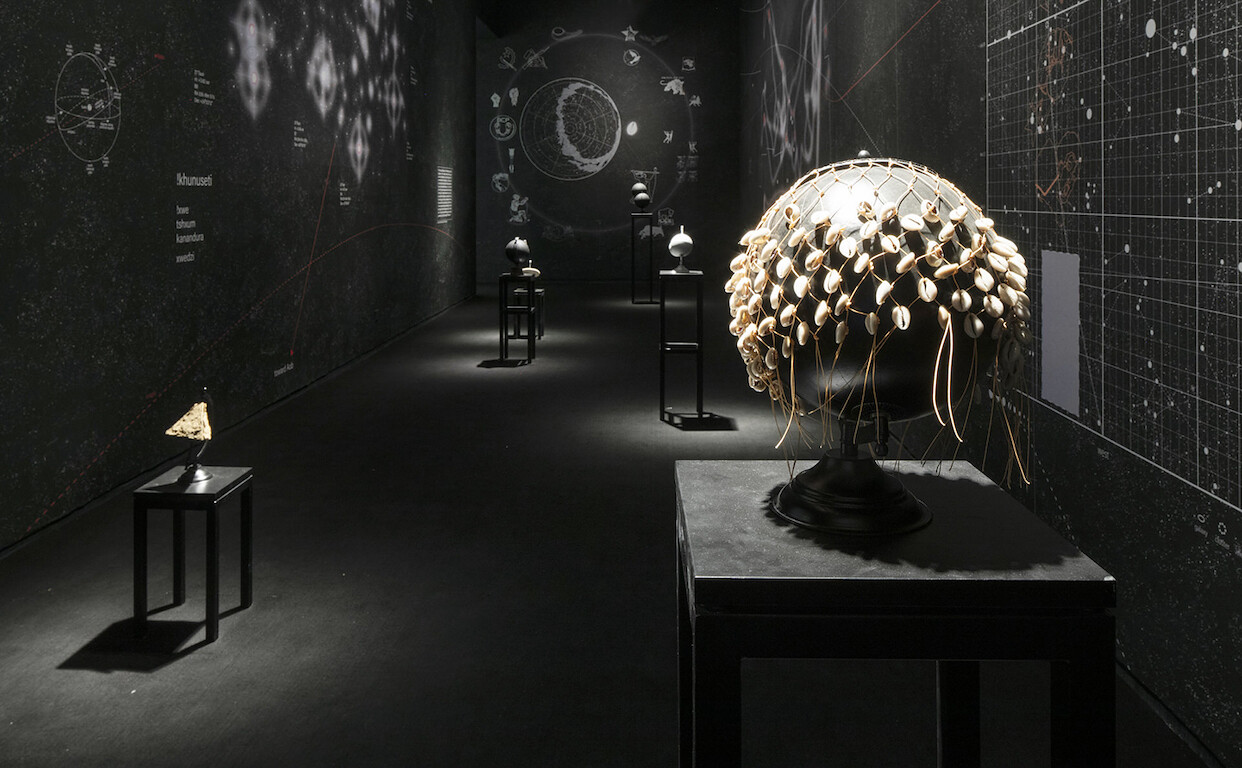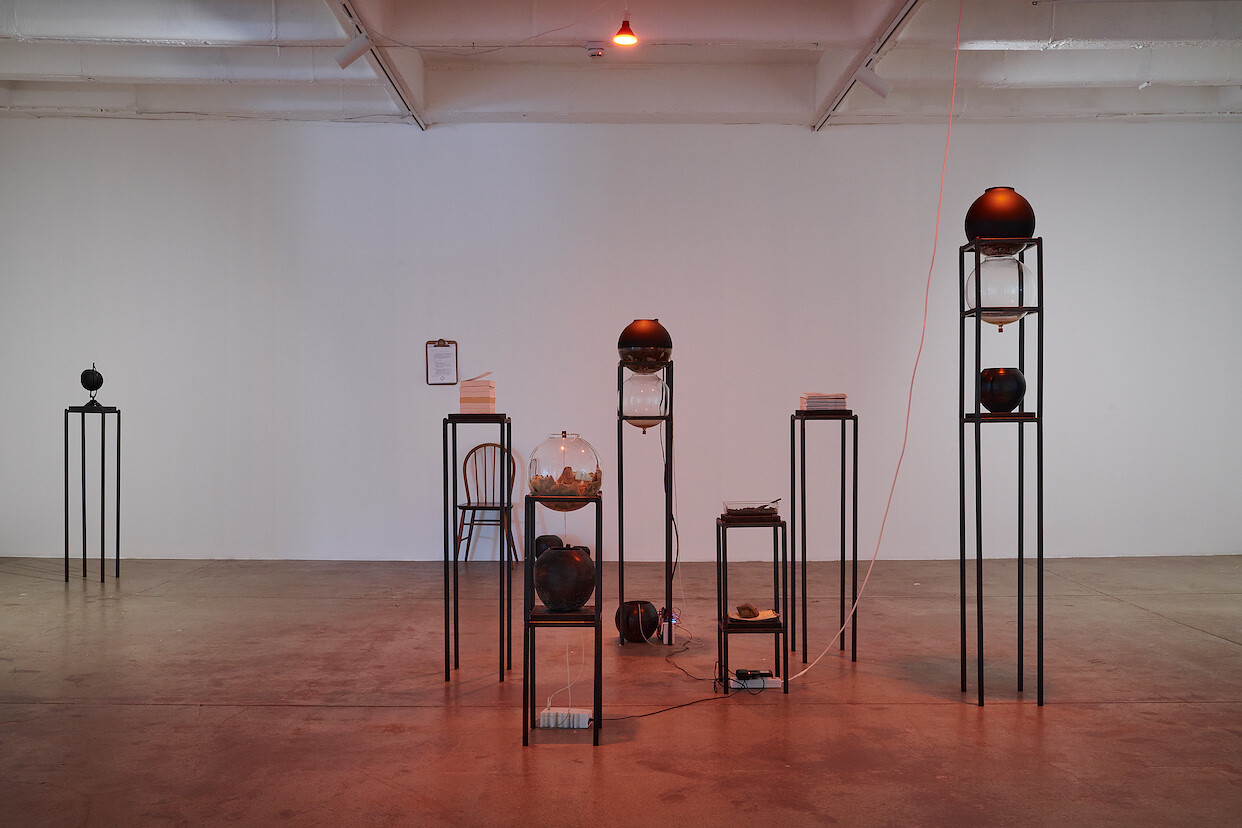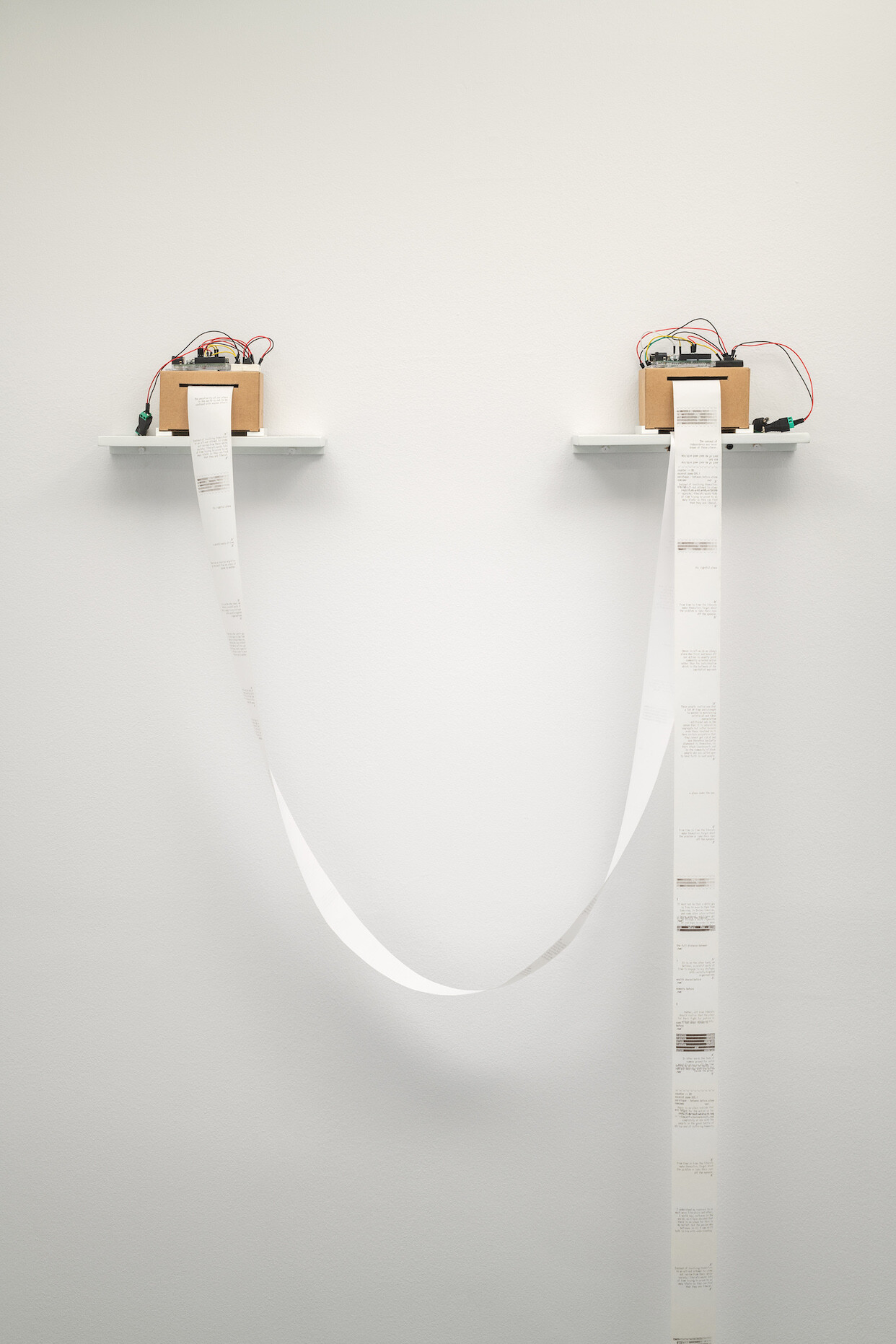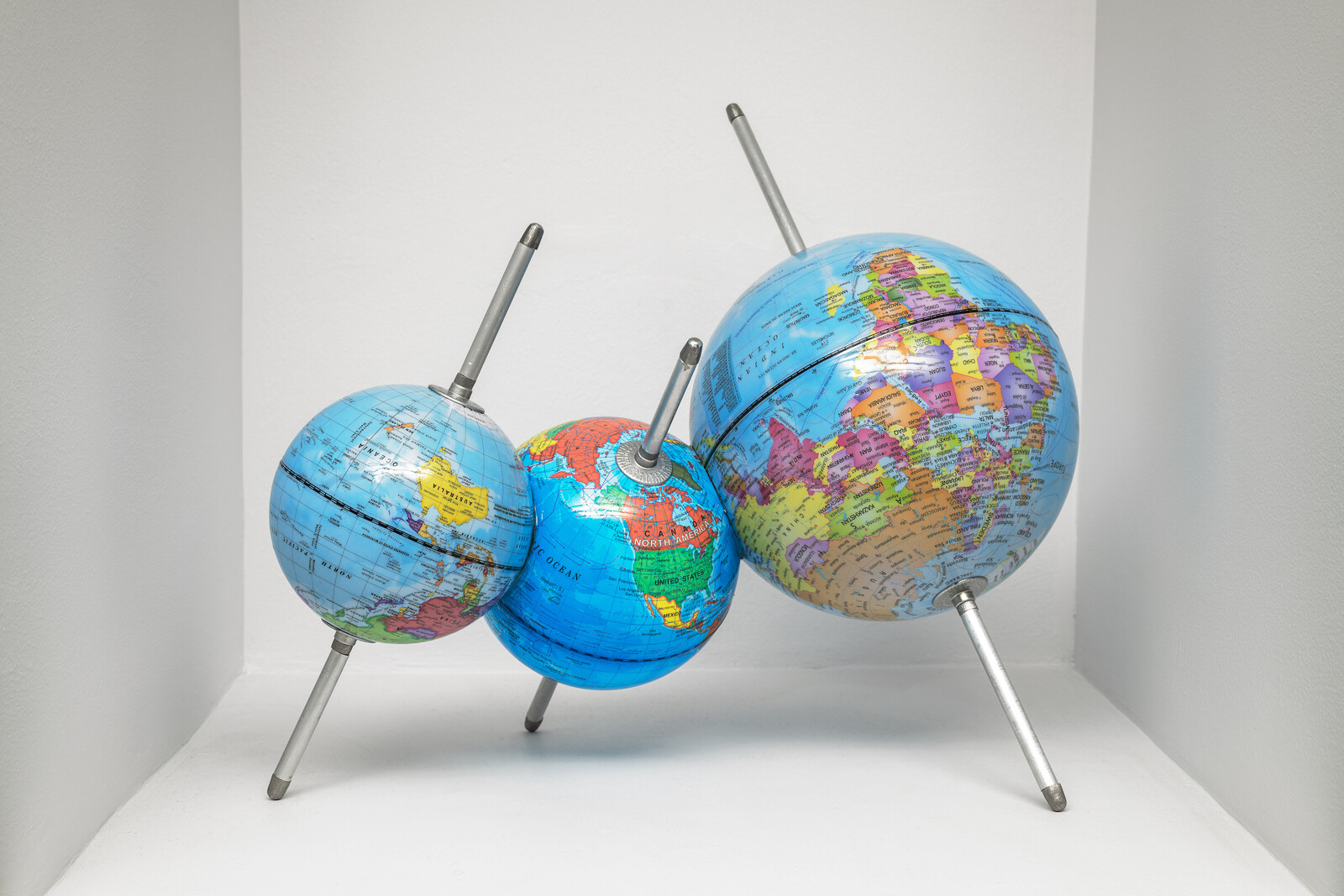Over the past three years, Nolan Oswald Dennis has gained significant international recognition, showcasing their diagrammatic and collaborative practice at two prominent Swiss museums in 2024 alone.1 The artist’s probative, sometimes opaque work—a mix of drawing, sculpture, film, and installation—also appeared in recent editions of biennales in Dakar, Liverpool, São Paulo, and Shanghai. These career milestones were bookended in late 2024 by an event closer to home: the artist’s first museum solo exhibition in South Africa. Organized by Cape Town’s Zeitz MOCAA, “Understudies” offers a broad overview of Dennis’s multifaceted practice, its speculative methods, iterative processes, rootedness in collaboration, and overall inclination towards “keeping a question open for as long as possible,” as the artist put it to me during a series of online conversations and email exchanges.
Curated by Thato Mogotsi, Dennis’s early-career survey includes small drawings on grid paper, variously sized hard and soft sculptures portraying globes (a recurring motif in their practice), a low-tech receipt printer issuing aphoristic chunks of text by anti-apartheid activist Steve Biko, as well as a drawing installation depicting a celestial body. The selection affirms the importance of models, diagrams, annotations, and simulations as forms for prompting critical thinking. Partly inspired by the artist’s training as an architect, Dennis is attracted to these “partial objects” and “dependent” forms because they “require a third party to pick up and complete, or not.”


Nolan Oswald Dennis, Black Liberation Zodiac: Khunuseti, 2023. Mounted wallpaper, altered plastic PET globe model, synthetic stone finish, white and black primer, cowry shell veil, dimensions variable. Courtesy of the artist. Image courtesy of Power Station of Art, Shanghai.
Key among the works in this analytical and graphic mode featured in “Understudies” is a new configuration of Dennis’s wall-based installation Black Liberation Zodiac (Molalatladi) (2018–ongoing). This iterative work, a version of which appeared in the 14th Shanghai Biennale, speculatively remaps the night sky, replacing references to Eurasian mythological history with imagery drawn from the archive of black liberation iconography, such as panthers, raised fists, doves, lions, and books. The series aims to expose, as well as creatively hijack, the power dynamics encoded in western scientific systems and the way they order knowledge, here heavenly bodies.
Notably, “Understudies” excludes Dennis’s installation garden for fanon (2021–ongoing), a living artwork composed of a community of earthworms displayed in an interconnected network of glass globes. Previously shown at Cape Town’s A4 Arts Foundation in 2021, this mischievous work requires its host institution to feed the earthworms with paper from Frantz Fanon’s The Wretched of the Earth (1961). Gifted this classic of liberation theory by their grandmother at age 12, Dennis admits they were “probably too young to understand what it all meant” at the time, but have since revisited the text frequently, notably in 2019 while preparing a work for “rocks,” a Johannesburg group exhibition curated by artists Chloë Reid and Matty Roodt.


Nolan Oswald Dennis, garden for fanon, 2021–ongoing. Bioactive system, books, glass globes, microcontroller, steel armature, dimensions variable. Courtesy of Goodman Gallery, Johannesburg. Photo by Anthea Pokroy.
Titled black earth (reader), this precursor to garden for fanon comprised a stack of five plastic storage containers hosting earthworms engaged in the “decompositional act” of converting Fanon’s book into what a wall text described as “flesh, energy, heat, and worm casings (shit).” The Zeitz MOCAA omission is rooted in logistical concerns handling a bioactive agent, but it also underscores the unwieldy surpluses and disobedient characteristics of Dennis’s self-styled “para-disciplinary” practice. It is a practice that emphasizes adjacency over opposition, flexible proximity rather than non-participation, and, importantly, iteration and testing over fixity and formal resolutions. “To quickly rush to certainty is a form of closure,” believes Dennis.
In this epistemic framework, works are not just objects but proposals for collective engagement. At Zeitz MOCCA, staffers were involved in the co-production of works like Xenolith (Letsema) (2024), a freestanding square column composed of packed soil in fantastical gradations of atypical colors: brown, mustard, pink, green, and even blue—Dennis typically uses black and grey. It is an attitude to labor and collective work informed by their biography. Dennis was born in 1988 in Lusaka, Zambia, to South African parents living in political exile. The family returned to South Africa in 1990, settling in Midrand, an unlovely space of corporate parks, new suburbs, and malls between Johannesburg and the administrative capital of Pretoria.


Nolan Oswald Dennis, Xenolith (Letsema), 2024. Collaborative site-specific intervention. Image courtesy of Zeitz MOCAA. Photo by Dillon Marsh.
Growing up in this liminal space somehow amplified Dennis’s complicated sense of belonging. “It took me a while to figure out that exile is a condition not a place,” Dennis reflects, adding, “the sociality rather than the explicit politics” of an exile community were formative. The youthful experience of immigrant-shaming has also prompted Dennis to always assert their Zambian origins. “The fact of my birth is also an artifact of the struggle [against Apartheid], a history which makes me this un-South African South African.”
Dennis’s entry into the art world was gradual and unplanned. Initially they studied politics, philosophy, and economics at the University of Cape Town, but later pivoted to architectural studies at Wits University in Johannesburg. “I wasn’t particularly interested in buildings,” Dennis admits, “but architecture appealed because it felt like a field in which you could do something.” In 2010, during a class led by urban theorist AbdouMaliq Simone, Dennis saw the Black Audio Film Collective’s documentary The Last Angel of History (1996), in which director John Akomfrah deploys tropes from science fiction to investigate African diasporic experiences of migration and exile. The critical poetics and adjacent logics of the film resonated.
A childhood fan of Star Trek and Stargate, as well as a subscriber to educational magazine Techno Quest, Dennis graduated to speculative fiction as an adult—their reading list encompasses Octavia Butler, Samuel R. Delany, Ursula Le Guin, Doris Lessing, and Masande Ntshanga. For Dennis, science fiction provides a language for articulating the hidden structures of oppression and imagining collaborative paths toward liberation. “In science fiction, the idea of hidden structures is uncontroversial,” Dennis notes. “It’s no use trusting what you see or what you know; you need to find another device, another piece of knowledge, another community of knowers, or make one.” It is a modus operandi evident in their work, which often invites audiences to participate in the process of meaning-making, and being exploratory and open-ended is easily revisable.


Nolan Oswald Dennis, biko.fanon, 2018. Receipt printers, micro-controller, dimensions variable. Image courtesy of Zeitz MOCAA. Photo by Dillon Marsh.
The diagnostic function of this work draws not only on the logics of sci-fi but also the liberation theories and poetics of Fanon, Keorapetse Kgositsile, and Audre Lorde. “The world is always something made not found,” Dennis elaborated in an email. “In both science fiction and (serious) liberation theory the future is always necessarily queer, the struggle is to liberate our social becoming.” The operative word here is “becoming”—an active process rather than a fixed outcome. Dennis’s decision to return to Johannesburg in 2010 played an important role in translating their interest in writers, books, and words into a personal art grammar.
Newly returned to the city, the artist met likeminded individuals online and participated in a failed occupation in the real (hardly anyone showed up). This fluid movement between URL/IRL scenarios introduced Dennis to various protagonists in Johannesburg 2010s avant-garde, including CUSS Group, Keleketla! Library, and the agit-prop psych band The Brother Moves On. Dennis produced posters and set designs for live shows, including large-scale drawings that they describe as early prototypes for their current analytical murals. This enthused hustle also led Dennis to artists Bogosi Sekhukhuni and Tabita Rezaire, with whom they later founded the collective NTU as a framework to explore the intersections of race, technology, and identity.
NTU’s alert post-digital thinking and critique of the hegemonies that frame the production and diffusion of digital technology remain inspiring. In 2023, the Kunsthalle Bern surveyed NTU’s collaborative practice. “The collaborative thing was a way for us to make sense of things together,” says Dennis of NTU. “That is still the way I think about collaborative practice. There are certain things I cannot know without somebody else.” This understanding of art as a social endeavor encompasses not only the form and life of their art objects, but extends to how artists work. In downtown Johannesburg, Dennis co-runs a collaborative studio space with artists Dorothee Kreutzfeldt and Nono Motlhoki. This shared space, housing eleven other artists, is a concrete expression of Dennis’s belief in the transformative potential of collective action.


View of Nolan Oswald Dennis’s “Understudies” at Zeitz MOCAA, Cape Town, 2024–25. Image courtesy of Zeitz MOCAA. Photo by Dillon Marsh.
“For me, cultural work means practicing while thinking about the conditions of practice,” Dennis explains. This ethos ties their artistic labor to the social fabric of the city, emphasizing the necessity of collaboration to reimagine the conditions under which art—and public culture—can thrive. The act of thinking is important to Dennis, and crucially exceeds the privileges of currently being alone in a temporary studio in Paris for six months. “Thinking is something we do together,” Dennis explains, framing their works as collaborative acts that surpass their immediate boundaries. It is an attitude rather than a philosophy, one that pushes against the commodification of art, which often demands clarity and closure, and instead embraces ambiguity as a space for collective exploration.
In essence, Dennis is asserting their right—and that of their work—to complexity and irreducibility. Legibility and sense making are however defining hallmarks of exhibition making. While Dennis has achieved significant acclaim within the global art circuit, they remain deeply skeptical of its limitations. Which is why exhibitions, for Dennis, are not endpoints but operate as testing grounds—spaces where ideas can be refined and challenged in dialogue with audiences. “An exhibition is a public resource,” Dennis told me, but its liberatory capacity to provoke collective thinking and dialogue is also limited. It is why they stand adjacent to the art world, nurturing their practice next to rather than within it. “The art world is a strange way to form a temporary public, a place to think in public, with people I would otherwise never engage with, learn from, learn with,” offers Dennis. “Emancipation is something else.” Its site is outside the museum.
Nolan Oswald Dennis’s “overturns” is on view at the Swiss Institute, New York through April 13, 2025.
They include the exhibition “Umhlaba uyalingana” (2023), surveying their collaborative practice, at Kunsthalle Bern and outdoor mural commission a recurse 4 (3) worlds at Kunsthalle Basel, on view from October 2023 to August 2024. Dennis also had a work in the group exhibition “More-Than-Planet” (2024) at Awareness in Art, Zurich.
